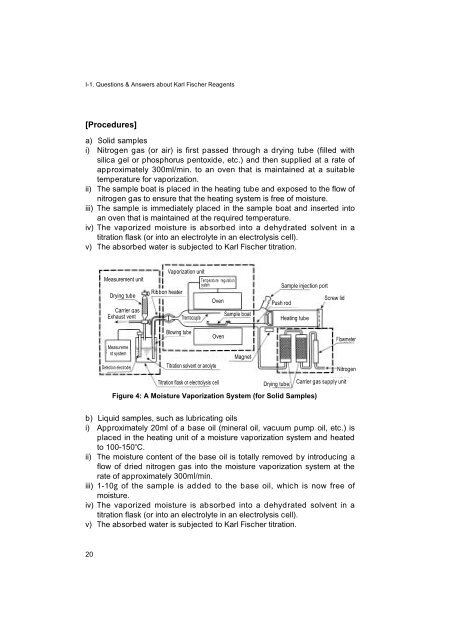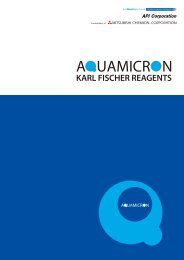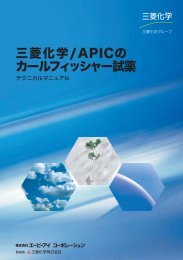Development of Karl Fischer Reagents
Development of Karl Fischer Reagents
Development of Karl Fischer Reagents
Create successful ePaper yourself
Turn your PDF publications into a flip-book with our unique Google optimized e-Paper software.
I-1. Questions & Answers about <strong>Karl</strong> <strong>Fischer</strong> <strong>Reagents</strong><br />
[Procedures]<br />
a) Solid samples<br />
i) Nitrogen gas (or air) is first passed through a drying tube (filled with<br />
silica gel or phosphorus pentoxide, etc.) and then supplied at a rate <strong>of</strong><br />
approximately 300ml/min. to an oven that is maintained at a suitable<br />
temperature for vaporization.<br />
ii) The sample boat is placed in the heating tube and exposed to the flow <strong>of</strong><br />
nitrogen gas to ensure that the heating system is free <strong>of</strong> moisture.<br />
iii) The sample is immediately placed in the sample boat and inserted into<br />
an oven that is maintained at the required temperature.<br />
iv) The vaporized moisture is absorbed into a dehydrated solvent in a<br />
titration flask (or into an electrolyte in an electrolysis cell).<br />
v) The absorbed water is subjected to <strong>Karl</strong> <strong>Fischer</strong> titration.<br />
b) Liquid samples, such as lubricating oils<br />
i) Approximately 20ml <strong>of</strong> a base oil (mineral oil, vacuum pump oil, etc.) is<br />
placed in the heating unit <strong>of</strong> a moisture vaporization system and heated<br />
to 100-150 � C.<br />
ii) The moisture content <strong>of</strong> the base oil is totally removed by introducing a<br />
flow <strong>of</strong> dried nitrogen gas into the moisture vaporization system at the<br />
rate <strong>of</strong> approximately 300ml/min.<br />
iii) 1-10g <strong>of</strong> the sample is added to the base oil, which is now free <strong>of</strong><br />
moisture.<br />
iv) The vaporized moisture is absorbed into a dehydrated solvent in a<br />
titration flask (or into an electrolyte in an electrolysis cell).<br />
v) The absorbed water is subjected to <strong>Karl</strong> <strong>Fischer</strong> titration.<br />
20<br />
Measurement unit<br />
Drying tube<br />
Carrier gas<br />
Exhaust vent<br />
Measureme<br />
nt system<br />
Detection electrode<br />
Vaporization unit<br />
Temperature regulation<br />
system<br />
Ribbon heater<br />
Oven<br />
Thermocouple<br />
Blowing tube<br />
Titration solvent or anolyte<br />
Oven<br />
Sample boat<br />
Magnet<br />
Sample injection port<br />
Push rod<br />
Heating tube<br />
Screw lid<br />
Titration flask or electrolysis cell<br />
Drying tube<br />
Carrier gas supply unit<br />
Figure 4: A Moisture Vaporization System (for Solid Samples)<br />
Flowmeter<br />
Nitrogen




